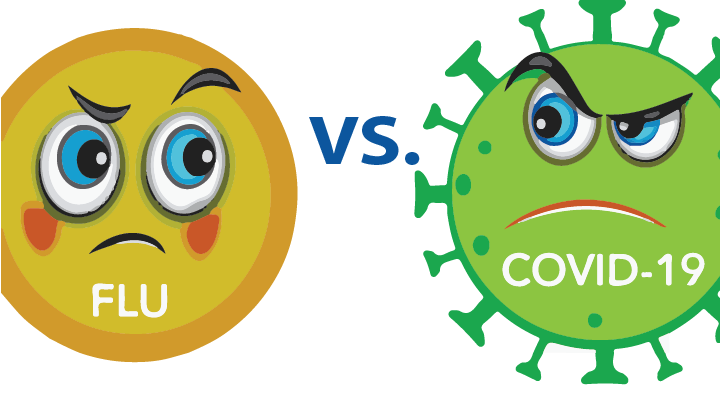10.29.2020
The Flu vs COVID: How Do I Tell the Difference?
It’s the time of year when we start to be concerned about catching the flu, but this year we also have to worry about catching COVID-19. If you develop symptoms, how do you know the difference?
Both illnesses have many similar symptoms:
- Fever or chills
- Cough or chest discomfort
- Shortness of breath or difficulty breathing
- Fatigue
- Muscle or body aches
- Headache
- Sore throat
- Congestion or runny nose
There are some differences:
- Loss of sense of taste or smell – This is associated with COVID-19, but the reported frequency of these symptoms varies widely. The symptoms may come on quickly and can also occur before any other symptoms appear. For some positive with COVID-19, one of these may be the only symptom they exhibit.
- Breathing difficulties – This is common in COVID-19, but less common with flu, unless the individual has some underlying lung disorder that causes shortness of breath, such as asthma or COPD.
- Gastrointestinal (GI) symptoms – Nausea, vomiting and/or diarrhea may occur with COVID-19. These are not frequently seen with the flu, although children may have nausea and vomiting.
When do symptoms appear after becoming infected?
Flu symptoms usually appear within 1-4 days after an exposure that causes an infection. Symptoms of COVID-19 most commonly occur around day 5 after becoming infected, but may appear as early as 2 days later or up to 14 days.
How will I know what I have?
There are tests for both the flu and COVID-19. As we move into flu season, you may be tested for both if you are seen for the symptoms noted above. The commonly used tests for the influenza virus will yield results within 15-30 minutes. There is a rapid test available for SARS-CoV-2 which is quite accurate if a positive result is obtained, but has a high false negative rate. For this reason, it is also suggested anyone with a negative rapid test, have the PCR test also performed. The more accurate PCR test may take 2-5 days for results.
What should I do?
If you are diagnosed with either the flu or COVID-19, you should avoid contact with others so you don’t spread the illness. During this COVID-19 pandemic there are specific public health requirements for those with COVID-19. You will be contacted by the health department giving you instructions. Assuming you do not require hospitalization, you will need to stay at home and isolate yourself from the rest of the household for a minimum of 10 days since the onset of your symptoms. Isolation is used to keep an infected individual away from everyone, including those in the same household. Ideally, you will need to move into a separate room by yourself and use a separate bathroom. If you do need to be around others you need to wear a mask.
You will be able to resume your normal activities after 10 days if all your symptoms are improving, and you have not had any fever (and not taking any medicines to lower a fever) for 24 hours.
Are there medicines I can take?
There are not any medicines approved for treatment of COVID-19 outside of a hospital setting. There are anti-viral medications used to treat the flu, especially in those at high risk of developing complications from the flu – oseltamivir (Tamiflu), zanamivir (Relenza), peramivir (Rapivab) and baloxavir (Xofluza). Your doctor will determine if you need to be prescribed an anti-viral medication.
You can take over the counter medicine (if you are not allergic or have other reasons you cannot take these medications) and there are other actions you can take to decrease your symptoms:
- Fever – acetaminophen (Tylenol), NSAID’s (ibuprofen (Advil), naproxen (Advil), aspirin)
- Cough – cough syrups or lozenges
- Sore throat – throat lozenges, acetaminophen, NSAID’s, drinking warm liquids (with honey), gargling with salt water
- Muscle or body aches – acetaminophen, NSAID’s
- Fatigue – rest
- Overall weakness – continue to eat healthy and drink fluids
When should I seek emergency medical help?
- Trouble breathing
- Persistent pain or pressure in your chest
- New confusion
- Inability to wake or stay awake
- Bluish lips or face
- Very weak and symptoms worsening
Prevention:
- GET YOUR FLU VACCINE! Flu vaccines are not 100% preventative, but they do make a difference in the number of flu cases we would be seeing if we did not have a vaccine. Also, if you get the flu in spite of having been vaccinated, the symptoms tend to be milder. This is very important to avoid over-burdening our local hospital, which will also be treating patients with serious COVID-19 infections.
There is not currently a vaccine available for COVID-19, but several are now being tested for safety and efficacy. When one is available, get vaccinated.
- Continue to wear a face covering, wash or sanitize your hands often and stay at least 6 feet from others helps to decrease the spread of the viruses that cause both of these illnesses. Avoid crowds, especially where mask wearing is not being practiced. And be especially vigilant at gatherings with family and friends, as this is currently where the majority of COVID-19 cases are occurring.
References:
https://www.cdc.gov/flu/index.htm
https://www.cdc.gov/coronavirus/2019-ncov/symptoms-testing/symptoms.html
Download a pdf of this article